- Amaranth Seed
- Buckwheat: Edible Leaves, Seed Set, Success, and a Recipe
- New Varieties of High-Lysine Corn Show Promise for the Small Farm
- Drought-Tolerant Corns from Plants of the Southwest
- Doing Your Own Corn (Maize) Improvement
- Quinoa, Chenopodium quinoa, is a Nutritious Grain from the Andes
- Book Review: A Farmer's Primer on Growing Rice
- Giza Sorghum for Food and Fuel
- "Bird-Resistant" Grain Sorghum
ARAMANTH SEED. Aramanth grain, corn and beans were probably the primary foods of the Aztecs. The Aztecs unfortunately practiced a religious observance in which they would mix blood from a human sacrifice with popped amaranth grain. They formed this into a statue of a war god, worshiped the statue, then ate it. The Conquistadors considered this a mockery of the eucharist (communion) so banned both the religion and cultivation of the grain in 1517. Amaranth has existed primarily as a wild weed since that time.
Amaranth received much research attention in the 1970s and 80s because:
(1) it is more resistant to drought than corn,
(2) it does fairly well in nutrient deficient soil,
(3) it produces yields that compare favorably with corn and rice,
(4) the grain is high in protein of unusually high quality, and
(5) the leaves also have a good balance of proteins and may be cooked like spinach.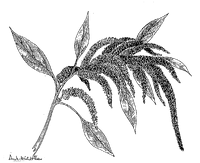
Much of the research was done by Rodale Institute (known for their many publications, including Organic Gardening magazine). They enlisted thousands of readers to do backyard experiments with different varieties of amaranth that they brought in from around the world. (This is a model for the kind of world-wide data we hope to gather as you report back to us on the seeds we send you.)
The protein is high in lysine, which accounts for 5% of total protein. It also has a very high "chemical score," a calculated value in which the higher numbers are the more perfect match for ideal human nutrition. For example, the chemical score for amaranth is 75-87, corn 44, wheat 57, sorghum 48, peanut 52, soybean 68, cow's milk 72. However, I have read results of feeding trials with rats where they did not do well at all on a corn/amaranth diet compared to corn and soybean. There are some anti-nutritional factors in raw amaranth that limits its use as a feed. Cooking improves this. Other drawbacks include small size of the seed that makes it difficult to thresh by machine and oxalic acid in the leaves that might tie up too much dietary calcium if eaten frequently in high amounts. You may request a summary of nutritional and cultivation information from ECHO. (See the chapter on Human Health for a perspective on nutritional limitations of amaranth.)
When evaluating amaranth for your area, you should try more than one species and variety, because the variability is considerable. A few of those we grew this year looked absolutely horrible, while others were truly beautiful crops. Amaranthus cruentus and A. hypochondriacus are grown primarily for their grain and A. tricolor for its leaves. Leaves of any variety can be eaten, however. Doug and Ruth Welcha are trying several of these varieties in Zaire. They just wrote that one variety (ECHO's #81-039) that they received earlier from Rodale grew 7 to 8 feet in composted soil. "Most of our neighbors demanded seeds, so it has been distributed near and far. But they are using it as a vegetable." This was one of the most prolific grain types for us.
Lloyd Rowlands sent us these comments from Zaire: "I planted two varieties of Amaranthus cruentus that I got from ECHO. I was pleasantly surprised by the yield. I gave a small quantity to my workman to try cooking. He tried it roasted--awful. Then he tried cooking it like rice--and asked me for seed! Variety 81-037 out-yielded 81-039. They were sown December 3 and harvested in March." ECHO has many varieties of amaranth seed, both types grown primarily for grain and those grown for their edible leaves. Please indicate with your order which type of amaranth you wish to try; we will send several varieties.
BUCKWHEAT: EDIBLE LEAVES, SEED SET, SUCCESS, AND A RECIPE. In the chapter on Domestic Animals we mention the experience with buckwheat, Fagopyrum esculentum, reported by John Trossel. He said this quick-maturing crop can be harvested two months after planting. Seed that we sent to a lower elevation (about 4,000 feet) in Honduras also reportedly did well. The newsletter HortIdeas quotes from an Indian journal that the leaves of this "broad-leaved 'grain' with remarkable soil-building abilities are edible. In fact, they are eaten regularly by people living in the higher ranges of the Himalayas. They are simply cooked with seasonings in boiling water for a short time. The leaves contain 4.5% protein on a fresh weight basis and are reasonably high in calcium and iron."
Buckwheat does best in cool and humid climates and is definitely not suited for the tropical lowlands. If you work at an appropriate site, we can send you a small packet to get started. Poultry can eat the seeds whole, but for other animals it must be ground. Some of our readers, wanting to make a flour for human use, have given up on buckwheat because it is difficult to prepare into a pure flour when grinding. (If you have had experience preparing buckwheat flour, please share it with us.)
Kevin Hendricksen with the Peace Corps in Honduras wrote, "I planted buckwheat at 1500 m in early June in an area that receives 1000 mm rainfall. The plants grew quickly, flowered in about five weeks, reached a height of 12-15 inches. But the seeds produced were empty and did not sprout when planted. I made another planting of the original seed from ECHO in July with the same results." We asked Dr. Obendorf at Cornell University for some ideas on what may have caused the empty seed. He said that the optimal temperature for flowering and early seed set of buckwheat is 18øC; at 25øC, there is 40% loss of seed set and seed weight. The plants flower over a period of about 6 weeks, but most of the seed set is during the first 2-3 weeks of flowering. Hollow seeds are probably those which are set late and form seeds which do not fill in. Under temperature stress, the early flowers will abort. Later flowers, however, may set seed, but it will be sterile. Other possibilities include inadequate pollination by bees or drought sensitivity.
Bill Lewis from Ethiopia visited ECHO and gave a good report on buckwheat seeds he obtained from our seedbank. When his family left Ethiopia, they left some plants nearly ready for harvest, and they were eager to see how the plant was used in their absence. He returned to Africa and sent this update: "We only had a few months to try it at about 5000 feet. We left our seed with church members when we went on furlough. We found that they love it. By adding a little wheat flour or oil they say it is as good as anything they have. I have some church property now with water available, so I will grow buckwheat continuously until the next rainy season for seed. We are really excited about the possibilities! The buckwheat here matures in 9-10 weeks and is prolific. The bees really love it. We will also be trying other things--even your chaya!" He also asked for recipes.
Martin Price offers this family recipe for buckwheat pancakes. Growing up in Ohio, we had buckwheat pancakes almost every morning from the time the weather cooled down in the fall until it became warm again in the spring. The reason it required cool weather is that we fermented the buckwheat on the cool porch or in the sparsely heated kitchen. To start, we mixed buckwheat 50:50 with wheat flour, then added some yeast and enough water to make a thick paste. By the next morning it had expanded to 2-3 times its original size. We then added enough water for a nice consistency for pouring pancakes. We never liked it the first morning, but ate it anyway. That night we added more of the buckwheat/wheat flour mix (but no more yeast) and the process was repeated. After the third day, the pancakes were absolutely delicious and gave a wonderful aroma when cooking. People who have eaten buckwheat pancakes from a mix (not fermented) do not know how good the sourdough approach can be. It is like a totally different food, and it is very filling in a pleasant way.
NEW VARIETIES OF HIGH-LYSINE CORN SHOW PROMISE FOR THE SMALL FARM. A variety of corn that contains much higher concentrations of the amino acid lysine than normal corn was developed by Dr. Ed Mertz at Purdue University in the 1960s. Lysine is the essential amino acid that is most limiting in diets composed mainly of cereals. One way to get extra 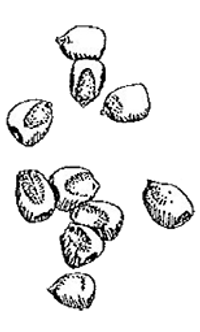 lysine is to mix cereals with beans. The high-lysine corn, however, would be much more nutritious than regular corn for folks or animals that do not have a good mixture of legumes with their corn.
lysine is to mix cereals with beans. The high-lysine corn, however, would be much more nutritious than regular corn for folks or animals that do not have a good mixture of legumes with their corn.
The high-lysine corn has not been widely accepted because its yields were inferior and the texture was not as acceptable for human diets in many countries. Dr. Mertz visited ECHO on his way home from the International Center for Improvement of Wheat and Maize (CIMMYT) in Mexico. He was quite excited because CIMMYT had just completed yield trials in several countries with some new varieties that have equaled or outperformed the best open-pollinated varieties and which have the preferred texture.
Open-pollinated corn is the kind farmers plant year after year using seed that they harvest (as opposed to purchased hybrid corn). Most of you know that if farmers save and plant their own seed the next year from hybrid varieties, subsequent yields can be variable and much less productive. CIMMYT is to be congratulated for concentrating on open-pollinated corn, which is more appropriate than hybrid corn for those farming at near subsistence levels. If there is no sacrifice of yield, high-lysine varieties should be seriously considered for the small farm. Human and animal health would both be improved. Some farmers in the United States claim that they save $2-10 per hog when they feed high-lysine corn, mainly because it allows them to reduce the amount of soybeans in the diet by up to 25%. They also claim fewer veterinarian expenses. (I have seen no scientific studies on either point.)
If you want to try the new corn, you should be cautious about a few things. First, an unusual trait of the high-lysine corn is that if it is pollinated by normal corn the crop that is harvested will not be high in lysine. Therefore, if it were introduced to an occasional small farm which is immediately surrounded by fields of regular corn, the extra nutritional benefits might not be present. All farmers in an area should agree to grow the high-lysine crop unless fields were somewhat isolated. Second, there is risk in changing all of a farmer's crop to a single new variety. Quite likely the local varieties have developed resistances to disease and insects common to the area. Although the new varieties have no doubt been developed with resistance to common tropical stresses, there is some risk (and scientific loss) if the old varieties are no longer grown.
The director of the Maize program at CIMMYT told us that it would be best if ECHO's network would write CIMMYT for seed, rather than sending seed to ECHO for redistribution. This would enable them to send appropriate types. They have both highland and lowland varieties and also different grain types and maturities, so tell them something about your climate, altitude, length of season and any preferences as to type and texture of the corn so they can make the best choice. Write CIMMYT, Londres 40, Apdo. Postal 6-641, Col. Juarez Deleg. Cuauhtemoc, 06600 Mexico, D.F. MEXICO.
DROUGHT-TOLERANT CORNS FROM 'PLANTS OF THE SOUTHWEST' CATALOG. Posole Corn: "Large, plump ears on vigorous, drought-tolerant plants. The traditional variety of dry dent corn for making posole, the hominy and one of the finest dishes of the Southwest. 100 days." apago: "Small, slender cream-colored ears on this drought-tolerant corn adapted to the extremely arid region of southern Arizona. Larger in wetter climates or with regular irrigation. Grind into meal for tamales. Excellent for harsh, dry sites. 80 days." Buhrow's White Desert Sweet Corn (ask for it even if not listed in their catalog): "A new cross of papago with a white corn to produce a sweet corn that will open pollinate between 90-100 deg.F. It is remarkably drought tolerant and has been known to bear when deeply watered only 3 times in a season, but your yield will be greater with more frequent waterings. Grows 5-9 feet with 6-9 inch ears." [NOTE ON CORN: We bought this from a commercial seed company, so it should be disease free. If corn is important in your area, be watchful and destroy the plants if any new disease should ever appear.] ECHO can send you a small packet to evaluate. Though you can save your own seed, it is best to have a minimum population of perhaps 200 plants in a field to prevent inbreeding. You can later order larger quantities from Plants of the Southwest, Agua Fria, Rt. 6 Box 11A; Santa Fe, NM 87505, USA; phone 505/471-2212; phone orders 800/788-7333; fax orders 505/438-8800 ($20 minimum). Their catalog features many other drought-tolerant corns and plants you may wish to try.
DOING YOUR OWN CORN (MAIZE) IMPROVEMENT. Bob Short in Mexico teaches farmers to improve their own open-pollinated (not hybrid) corn varieties. The people already select the best ears for seed, but the selection is made from a pile 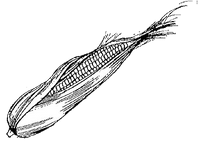 after the harvest. Selection based on ear size only can cause more problems than you might think. This brings up an interesting story.
after the harvest. Selection based on ear size only can cause more problems than you might think. This brings up an interesting story.
In the early 1900s in the United States a popular magazine, "Wallace's Farmer," and a professor at Iowa State University promoted corn competitions. These became annual events all over the midwest. Judging was based on a vision of the ideal corn: uniform ears, 10 inches long, with even rows and deep kernels shaped like a keystone. At one of the professor's talks a 16-year-old boy (the editor's son) asked whether seed from the ideal ear would produce more corn than any other. "Of course," he replied, though he had not tried it. The boy's persistence made him nervous, so he collected 25 ears of the best show corn and 25 of the poorest. The highest yield came from an ear no corn-show judge would look at twice. As a whole, the highest-ranked show ears produced less than those that ranked lowest. The boy went on to school and later formed what became the largest corn seed company in the world, Pioneer Hybrid, and eventually was Secretary of Agriculture.
Bob finds that even after selecting the best ears for seed, about half of the plants produce a poor ear, if any at all. Bob decided that the basic traits that he wanted were present in one plant or another in the field of "criollo" corn, though not necessarily on the same plant. He wrote, "Our method of selection is simple. The first thing we do is de-tassle the poor plants before pollination. This ensures that reasonably good plants will be the male parents of the corn. Then we select the ears to be kept for seed in the field. We take from the best plants which produce a good ear, taking into account the quality of the roots, stem, disease resistance, leaf area, etc." The important difference in this method is that good ears come from plants that are also known to be good.
"We have seen problems of inbreeding, so now recommend that seed come from fields that are at least half a hectare in size and that a minimum of 400 ears be selected. The selected ears are shelled and the seeds are thoroughly mixed together and saved for the next planting."
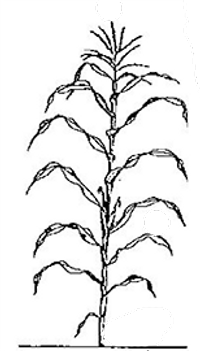 Bob says that they have definitely improved the quality of their own corn. It is difficult to convince farmers to change to it though because improvement is too slow to be seen quickly. A few are beginning to try it and he hopes that in 5-10 years it may be widespread.
Bob says that they have definitely improved the quality of their own corn. It is difficult to convince farmers to change to it though because improvement is too slow to be seen quickly. A few are beginning to try it and he hopes that in 5-10 years it may be widespread.
I asked Dr. David Unander, a plant breeder on ECHO's Board of Directors, to comment. Highlights of his reply follow. "How many ears should one save to avoid inbreeding? Plant breeding texts and research suggest a minimum of 30 plants to avoid serious inbreeding, but much more is better. Unneeded seed can always be eaten. The extent of inbreeding is a function of the percentage of the population saved and will increase substantially if much less than 10% of the harvest is saved and mixed in the seed bin."
Dave suggests a way to further improve the technique. "Because differences among plants depend on the local spot in which the corn plant is grown, mentally divide the field into little blocks of 10-20 plants each (or more in a larger field). Be sure to select the best ear or ears from each of these imaginary blocks. Plants with mediocre genetic traits may have done well just because they grew in an unusually fertile spot, and plants that are outstanding may have done poorly if they grew in a poor part of the field." [This would also help to keep in your pool of seeds traits that would enable the best performance possible in those poor parts of the field.]
A special merit of Bob's method is "that he has thought out exactly what he wants to select: he has a mental picture of what a good corn plant would be like for his area. This is one of the most important things to establish before beginning any breeding program."
QUINOA, CHENOPODIUM QUINOA, IS A NUTRITIOUS GRAIN FROM THE ANDES. "While no single food can supply all of the essential life-sustaining nutrients, quinoa comes as close as any other.... It holds exceptional promise as a weaning food. This crop was a staple in ancient times, second in importance only to corn in the Incan empire, and it is still an important grain crop in Bolivia, Chile, Ecuador, Peru, and Colombia. "Its grain is rich in protein and contains a better amino acid balance than the protein in most cereals. ...Today it is made into flour for baked goods, breakfast cereals, beer, soups, desserts and even livestock feed. When cooked in water, it swells and becomes almost transparent. It has a mild taste and a firm texture like that of wild rice.... Traditionally, quinoa is prepared like common rice or is used to thicken soups, but some varieties are also popped like popcorn."
"Quinoa has demonstrated value as a partial wheat-flour substitute for enriching unleavened bread, cakes, and cookies. Blends of 70% wheat and 30% quinoa flour produce fully acceptable loaf breads. Quinoa is called a "pseudocereal" because its use is similar to that of cereals but the plant is not in the grass family. Seeds are produced in large sorghum-like clusters and may shatter easily. They contain 58% starch, 5% sugar, 12-23% protein and 4-5% fat. It is a hardy plant, growing to 0.5-3 meters tall, maturing in 5-6 months with short day length. A drawback is that seeds of most varieties contain saponins, which impart a bitter flavor unless washed out in cold water or milled out. Quinoa has an exceptionally nutritious balance of protein, 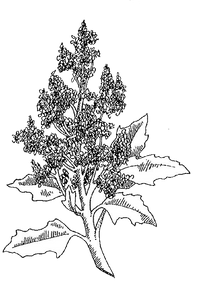 fat, oil and starch. The embryo takes up a greater proportion of the seeds than in normal cereals, so the protein content is high. Quinoa seeds average 16% protein but can contain up to 23%, more than twice the level in common cereals.
fat, oil and starch. The embryo takes up a greater proportion of the seeds than in normal cereals, so the protein content is high. Quinoa seeds average 16% protein but can contain up to 23%, more than twice the level in common cereals.
According to Underexploited Tropical Plants with Promising Economic Value, quinoa may prove to be a better protein source than most of the true cereals. It is "high in the essential amino acids lysine, methionine and cystine, making it complementary both to other grains (which are notably deficient in lysine) and to legumes such as beans (which are deficient in methionine and cystine). Quinoa is higher than wheat, corn or white rice in iron (6.6 mg, 4.6, 3.7, and 0 mg respectively.), phosphorus (449, 224, 207 and 143 mg), and calcium (141, 36, 6 and 8 mg).
Quinoa's large seedheads and broad leaves make it look something like a cross between sorghum and spinach. Visitors who see quinoa at ECHO before seed heads form almost always think it is the (edible) weed lambsquarter, to which it is closely related. The leaves are eaten fresh or cooked. Nitrates and oxalates, high enough in some greens to be a health concern, are very low in quinoa leaves.
Quinoa has been grown almost exclusively in the Andean countries which were formerly part of the Incan empire. In the Andes, it is primarily a food of campesinos, although in some areas it is gaining popularity among wealthier urban classes who realize its nutritional benefits. The increased interest in these countries of origin is due in part to efforts of local governments and increasing interest in healthful foods, and in part to its growing popularity in western countries, where new, tasty and healthful foods bring a premium price.
Quinoa is known for its resistance to tough conditions. It will grow where corn will not because of cool weather and dry conditions. During a devastating drought in the altiplano in 1982-83, 66% of Bolivia's potato crop was lost, 25% of corn, 54% of barley, 44% of wheat, 34% of cassava but only 7% of quinoa. In Peru the figures were 27% potato, 6% corn, 26% barley, and 0% for quinoa.
There is great diversity in plant characteristics. "A classification based on ecotype recognizes five basic categories:
(1) Valley type, grown in valleys from 2,000-3,600 m. Tall, branched, long growth periods.
(2) Altiplano type, frost hardy, short, unbranched, short growth periods and compact seedheads.
(3) Salar type, native to the salt flats in the Bolivian altiplano.
(4) Chilean type, grown at low elevation sites between 34øS and 41øS in Chile, will flower even with long days.
(5) Subtropical, located in intermontane valleys in Bolivia, intensely green plants that turn orange at maturity and have small, white or yellow-orange seeds."
Farmers and scientists in parts of the industrialized world where weather in the summer months resembles weather in the Andes have been trying to develop quinoa as a crop since the early 1980s. Because they originated near the equator where days are short, most varieties are daylength sensitive (require short days to flower) and do not do well. However, there are varieties which grow near sea level in Chile where days are long. These have proved more adaptable to high latitudes.
A drawback to quinoa production and use on a small scale is that the seeds contain saponins in the seed coat, which cause the grain to be extremely bitter. They can easily be mechanically removed with appropriate equipment. Lacking such equipment, the grain can be rinsed or soaked in water to dissolve the saponins. However, it is more difficult to get a uniform product this way. I spoke with Dr. Duane Johnson at Colorado State University about quinoa and its potential. He had just returned from harvesting his experimental plots of quinoa in Colorado.
Q. We know that the equatorial types require short days to produce seed but that Chilean types do not. Do Chilean quinoas actually require long days or are they day-neutral (produce in any daylength)?
A. They are day-neutral. That means that if ECHO sends Chilean seed to its network, it should not fail because of daylength. 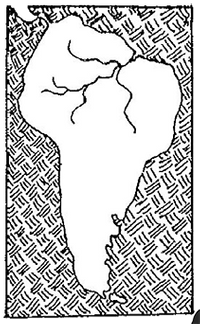 However, people in equatorial highlands would probably prefer equatorial types. They tend to have larger, white seeds; Chilean quinoas are smaller and colored. White seeds are generally softer and it is easier to remove the bitter saponins. Chilean types are harder and more extensive work is required to remove the saponins.
However, people in equatorial highlands would probably prefer equatorial types. They tend to have larger, white seeds; Chilean quinoas are smaller and colored. White seeds are generally softer and it is easier to remove the bitter saponins. Chilean types are harder and more extensive work is required to remove the saponins.
Q. The Chilean types are unbranched. Does that mean they should be planted more densely than equatorial types?
A. Yes. We plant 2 pounds/acre of equatorial seed but 5 pounds/acre with Chilean. That corresponds to a plant spacing of 3-4 inches (7.6-10 cm) and 2 inches (5 cm) respectively. Most farmers in Colorado use rows 16 inches (40 cm) wide, but some use 8 and others 20 inches (20 and 50 cm), depending on moisture. (If rainfall is limiting, ha ving fewer plantswith wider spacing will require less water.)
Q. What are the climatic boundaries beyond which quinoa has little potential? Will Chilean sea level types do well in tropical lowlands?
A. They have the greatest heat tolerance, but we don't recommend them where temperatures exceed 92 deg.F/33 deg.C, especially during the flowering period (July here in Colorado). We have quinoa growing from Finland to Australia, but mostly in temperate regions. Quinoa is very susceptible to downy and powdery mildew. It likes low humidity. Cool nights are probably important, though I have no data to prove that. It does well here where temperatures average 80 deg.F day, 45 deg.F night (27 deg.C and 7 deg.C). It does not do as well in broad valleys where night temperatures remain rather high, though at 7,000 feet it does great even in valleys.
[NOTE: Because it flourishes at high altitudes (2500-4000 m), we thought we might have a chance of growing quinoa at ECHO in southern Florida during the cool winter season. It has exceeded our expectations in some years, growing quite vigorously and forming grain. We are interested in examining it more closely to determine whether it has potential for a much wider range of climates. Dr. Russell Seibert at the Marie Selby Gardens told me that he thinks he has heard reports of it growing quite successfully in Alaska. An association, Sierra Blanca Associates, 2560 S. Jackson, Denver, CO 80210, USA, has been formed for its promotion and trial. It grows best where maximum temperatures do not exceed 90 deg.F (32 deg.C) and night temperatures are cool.]
Q. Are there subtropical quinoas?
A. There are related species, mainly back garden types. They grow, for example, in parts of Mexico. [Ed: Can anyone give 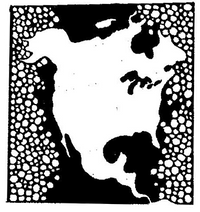 ECHO some seed?]
ECHO some seed?]
Q. I read that the equatorial quinoas grow so well in Colorado that they might make good forage.
A. Equatorial types produce tremendous biomass here, but we get no seed production. It could be used for forage only if we imported seeds.
Q. How complex is it to remove saponins at the "village" level?
A. It is pretty simple. Pillsbury Co. gave us a $7,000 rice dehuller (a carborundum stone that spins and knocks the coating off, designed for 3rd world countries). It works even with the harder Chilean types, though they require 2 passes. Once dehulled it tastes just as good. Actually I prefer the Chilean varieties, which to me have a richer, nuttier flavor. I find the equatorial types somewhat bland.
Q. Do the saponins give the color to the seed coat? If so, can you learn anything important by noting the color of the grain, e.g. whether birds might avoid it?
A. The saponins are buried in a pericarp, like the rind on an orange. Color does not really tell you anything useful. There is no correlation between color and bird resistance.
Q. What is the status of saponin-free varieties? Are they more prone to insect and disease loss?
A. We are currently investigating these varieties, but I have some hesitation after this year's results. Birds were definitely a more serious problem with saponin-free varieties--I'd estimate 30% loss to bird damage. This is in middle of a 150-mile valley with no trees within 2 miles of the plots. But migrating birds found it (other grain fields had been harvested). [Ed: Has anyone noticed whether bird damage is a more serious problem in general on farms making heavy use of agroforestry techniques?]
Q. I read that in early trials in Colorado improved, selected varieties from South America did not do as well as less selected varieties. Presumably the loss in variability during the selection process lost some traits that were important in Colorado. So should I offer your selected varieties to ECHO's network or will they likewise perform less well than the original seed might have done?
A. We find that selected lines from South America aren't as good for us. The same may be true of our varieties when tried elsewhere. We have selected two: Apelawa and Colorado 407. I maintained the old original material, which would probably be better for widespread preliminary trials.
Q. Is quinoa becoming commercialized outside the Andes?
A. About 500 acres are grown in Colorado and 200 each in Washington and Wyoming. It is processed and sold to health food industries. Until this year 50% was sold here and 50% went to Europe. This year 99% will be sold in the USA. Europeans are now buying from South America. Nestle invested $5,000,000 in Ecuador in research in quinoa. Starch from quinoa is being used in synthetic cream products. The market for quinoa is increasing. Canada is becoming a dominant force, growing 2,000 acres last year.
Q. Where are the main places for seed of diverse types? Are Andean countries hesitant to share seed?
A. Ecuador and Bolivia are very helpful in exchanging seeds with us. INIAP in Ecuador has equatorial types; write Estaci¢n Experimental Sta. Catalina, Km 14, Panamericana Sur, Quito, ECUADOR; fax 593 2 504 240. For Bolivia you should go and see what you can find. [NOTE: ECHO has many of the lines used in breeding by INIAP, if you want to select from domesticated but widely varying strains. Dr. John McCamant, Sierra Blanca Associates, 2560 S. Jackson, Denver, CO 80210, USA, also gladly shares from his sizeable quinoa collection.]
Q. Do you have any final comments?
A. There is a southern Bolivian type that I like very much. But it requires a longer season than we have in Colorado (105 days). I like it because it has larger seed and a softer pericarp, but is day-neutral.
If you want to try growing quinoa in your area, write to ECHO for sample packets. Dr. Johnson sent ECHO enough Chilean quinoa seed to send small introductory packets to our overseas network. These should bloom under the broadest range of day lengths (assuming that temperature and other conditions are right). We also have the virtually saponin-free commercial variety 'Tunkahu n' from the highlands of Ecuador. Our seedbank has several other varieties you may try, if you are interested in doing a broad trial with quinoa. We do not consider quinoa worth trying in hot, humid lowlands nor where high temperatures are much over 92 deg.F/33 deg.C.
[This article relied heavily on the book Lost Crops of the Incas, the National Academy Press, 1989, and an article "Quinoa: Grain of the Incas" by David Cusack, in The Ecologist Vol 14: 21-31, 1984. David, an early member of ECHO's network, was shot and killed during a 1984 trip to South America to collect quinoa seed.]
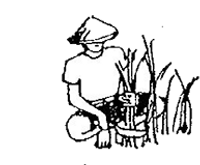 A FARMER'S PRIMER ON GROWING RICE. This book was written at the International Rice Research Institute (IRRI) to help the progressive rice farmer understand "why and how the improved rice varieties and farm technology increase production." The book answers questions such as why more fertilizer should be used in the dry season and how water depth affects seedling growth. It is clear and concise. The major part of each page is an illustration or diagram. Only a few words of explanation and clarification occur on the page. Some knowledge of rice production is assumed. For example, the mechanics of planting a seed bed, transplanting, harvesting, pest control and disease prevention are not covered. It does cover the life cycle of the rice plant in great detail and tells how the treatment of the rice plant at each stage will affect the final yield. Selected topics in the book are when and why to add fertilizers, factors affecting growth, factors affecting lodging, how to use yield components, control of weeds, carbohydrate production by the plant, use of herbicides and how to judge a rice crop at flowering. The book should be extremely helpful to an agriculturalist who is involved in training farmers. The illustrations and diagrams could be enlarged and used in teaching. The revised 1992 edition (219 pp.) costs US$3.25 plus postage. (The 1979 edition is available in Kiswahili for US$2.75 plus postage.) Order catalog from Information Center, IRRI, P.O. Box 933, 1099 Manila, PHILIPPINES. Their catalog lists local suppliers around the world which charge less postage and give faster delivery. IRRI has an excellent catalog and is your best contact for questions related to rice. ECHO does not carry rice seed.
A FARMER'S PRIMER ON GROWING RICE. This book was written at the International Rice Research Institute (IRRI) to help the progressive rice farmer understand "why and how the improved rice varieties and farm technology increase production." The book answers questions such as why more fertilizer should be used in the dry season and how water depth affects seedling growth. It is clear and concise. The major part of each page is an illustration or diagram. Only a few words of explanation and clarification occur on the page. Some knowledge of rice production is assumed. For example, the mechanics of planting a seed bed, transplanting, harvesting, pest control and disease prevention are not covered. It does cover the life cycle of the rice plant in great detail and tells how the treatment of the rice plant at each stage will affect the final yield. Selected topics in the book are when and why to add fertilizers, factors affecting growth, factors affecting lodging, how to use yield components, control of weeds, carbohydrate production by the plant, use of herbicides and how to judge a rice crop at flowering. The book should be extremely helpful to an agriculturalist who is involved in training farmers. The illustrations and diagrams could be enlarged and used in teaching. The revised 1992 edition (219 pp.) costs US$3.25 plus postage. (The 1979 edition is available in Kiswahili for US$2.75 plus postage.) Order catalog from Information Center, IRRI, P.O. Box 933, 1099 Manila, PHILIPPINES. Their catalog lists local suppliers around the world which charge less postage and give faster delivery. IRRI has an excellent catalog and is your best contact for questions related to rice. ECHO does not carry rice seed.
GIZA SORGHUM FOR FOOD AND FUEL. Dr. Axtell at Purdue University gave us a packet of seed of this special Egyptian grain sorghum and explained that in Egypt the stalks sometimes sold for more than the grain because of its superior burning characteristics. The grain is of good quality, though it can be damaged by rains near harvest. (As we have threshed it by hand, it seems that it is hard to remove all the "glumes" from the grain too.) Though we sent out several packets of seed in subsequent years, it was a long time before anyone in our network reported any excitement over it. Paul Butz's report from Peru is both encouraging and humorous.
ECHO was only able to send a small packet. Paul wrote that only 6 of 16 seeds germinated. Then two of these died of some disease. Later goats got in and ate half of the remaining four. The two that were left produced seed heads--then birds ate most of the seeds. By covering the heads with plastic bags he managed to get 200 seeds. Unlike in temperate climates where sorghum is an annual, a stalk that is cut back in the tropics may tiller (send up new stalks). Each of the two plants sent up 3-5 new stalks which in turn produced seed.
The immediate purpose of Paul's work is to "produce fuel for firing bricks in this area" as well as for cooking. They were expecting to plant a hectare which they calculated would produce enough fuel for the brick operation, giving at least three cuttings a year. Write ECHO if you would like to try seed of this sorghum.
"BIRD-RESISTANT" GRAIN SORGHUM. I [MLP] am especially pleased to make this offer because it relates to the subject of my three years post-doctoral research at Purdue University. Grain sorghum is one of the world's major cereals, grown primarily in locations which are just a bit too dry for reliable yields of corn. The plant looks like corn when young. Then a stalk emerges from the top of the plant on which a head of grain develops. Unlike corn, where the grain is protected by a husk, the sorghum grains are fully exposed. In some cases an entire field can be lost to birds.
There are two ways to protect the grain, neither very acceptable. One is to have the children or older people stay by the fields during the most susceptible weeks and scare the birds away. The other is to grow varieties which have a high tannin content. I once led a trial in Puerto Rico in which regular and high-tannin sorghums were grown on 3 acres. My plans for measuring degrees of damage by birds were discarded because there was 100% destruction of the kind with no tannin. The high-tannin varieties scarcely lost a grain.
So why is tannin not a good option? Tannin is the substance in green fruits (e.g. persimmons or banana) that causes your mouth to pucker up. The tannin binds with proteins, causing them to come out of solution. If this happens in your mouth, the lubricating proteins of saliva are removed, resulting in the puckery sensation. In the digestive tract they may tie up proteins in the diet or, worse yet, digestive enzymes. The consequences are serious. In feeding trials with rats and chickens, the animals grow much slower, or sometimes even lose weight, with rations based on high-tannin sorghum compared to varieties with no tannin.
Farmers face a terrible choice. Grow regular sorghum and risk low yields due to bird damage or high-tannin sorghum and get good yields of grain that is very bad nutritionally.
Dr. Larry Butler at Purdue gave me the good news that Dr. John York at the University of Arkansas and Roger Bullard with the U. S. Fish and Wildlife Service have a sorghum with no tannin that birds seldom bother. Dr. Butler's feeding trials showed that it was as good a feed as any other sorghum.
Dr. Butler says, "In trials in Indiana for two summers the new variety was not damaged at all, whereas susceptible lines in the same fields were totally destroyed. However, one planting in Puerto Rico, where the sorghum was planted next to some millet (a common ingredient in bird feed), was wiped out. So in special cases it can still be damaged."
Trials have been conducted in Brazil, Kenya and Tanzania. You might want to wait until a lot more research has been done. But if you would like to get in on a tiny trial yourself, Dr. Butler gave us enough seed to send you a trial packet. Plant a row in the same field as your other sorghum and see if there is a difference. I asked if it was important to plant in a separate location, thinking that perhaps the birds needed to learn that a particular patch of grain was not "tasty." He said that birds seem to be able to distinguish individual resistant sorghums right in the row. Be sure to let us know what you find. We will pass the results on to Dr. Butler.
Dr. York has just released the variety, called AR 3048. He said that no yield trials have been done. (I think it was released primarily for use by plant breeders.) It is a triple dwarf, which means it may only get to be knee high. The plants are just now blooming at ECHO at a height of about 3 feet (1 m). That does not mean yields will necessarily be low, as many commercial varieties are dwarf. Although the short stalks mean that there is less danger of lodging (falling over) in wind, there will not be long stalks after harvest for other uses.
Dr. York reported a trial in which 2% of grain was lost during the "milk" stage of grain development to birds with AR 3048 and  86% for a control. There was some loss in that case after the grain was more mature ("dough" stage). He had earlier released another variety which proved to be resistant some years and not in others. There are a lot of mysteries in just what is happening and what is responsible for this "bird resistance."
86% for a control. There was some loss in that case after the grain was more mature ("dough" stage). He had earlier released another variety which proved to be resistant some years and not in others. There are a lot of mysteries in just what is happening and what is responsible for this "bird resistance."
If you are inclined a bit toward plant breeding, note that this bird resistance is a recessive trait. If you cross with another variety the seed will produce plants that are not resistant.
Saidou Jallow in the Gambia reported: "The bird resistant dwarf sorghum did absolutely well. I find no fault in it. Both the people in my village and surrounding villages like it. I hope in the near future it will be widespread in the area because it has the following advantages: short duration, wind resistance, and less or no disease."
Dr. Butler did send this caution about the bird-resistant sorghum. In some parts of the world people roast sorghum, as with corn (roasting ears) in the United States. Larry cautions about consuming this variety fresh roasted. "The roasting would not detoxify the cyanogenic glycoside dhurrin, which seems to be responsible for its bird resistance. The levels of dhurrin are higher at the dough stage than in the mature grain. The conventional processing method (grinding and wetting and cooking) does eliminate the cyanide." He adds that in both Kenya and India he "was told that if food supplies are scarce it is better to have a small amount of sorghum than maize, because one is more satisfied and can work longer on sorghum. I presume slower digestibility is the reason." This would assure a slow release of nutrients to the body over a longer period of time.